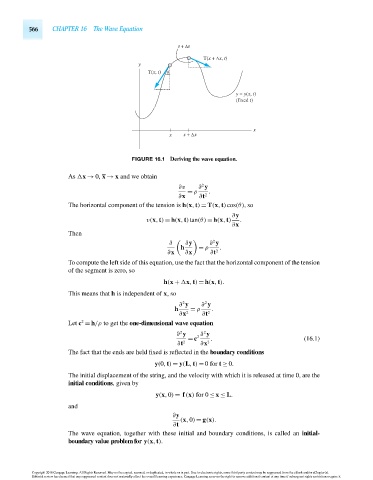Page 586 - Advanced_Engineering_Mathematics o'neil
P. 586
566 CHAPTER 16 The Wave Equation
θ + Δθ
T(x + Δx, t)
y
T(x, t) θ
y = y(x, t)
(fixed t)
x
x x + Δx
FIGURE 16.1 Deriving the wave equation.
As x → 0, x → x and we obtain
2
∂v ∂ y
= ρ .
∂x ∂t 2
The horizontal component of the tension is h(x,t) = T (x,t)cos(θ),so
∂y
v(x,t) = h(x,t)tan(θ) = h(x,t) .
∂x
Then
2
∂ ∂y ∂ y
h = ρ .
∂x ∂x ∂t 2
To compute the left side of this equation, use the fact that the horizontal component of the tension
of the segment is zero, so
h(x + x,t) = h(x,t).
This means that h is independent of x,so
∂ y ∂ y
2
2
h = ρ .
∂x 2 ∂t 2
2
Let c = h/ρ to get the one-dimensional wave equation
2
2
∂ y ∂ y
= c 2 . (16.1)
∂t 2 ∂x 2
The fact that the ends are held fixed is reflected in the boundary conditions
y(0,t) = y(L,t) = 0for t ≥ 0.
The initial displacement of the string, and the velocity with which it is released at time 0, are the
initial conditions, given by
y(x,0) = f (x) for 0 ≤ x ≤ L.
and
∂y
(x,0) = g(x).
∂t
The wave equation, together with these initial and boundary conditions, is called an initial-
boundary value problem for y(x,t).
Copyright 2010 Cengage Learning. All Rights Reserved. May not be copied, scanned, or duplicated, in whole or in part. Due to electronic rights, some third party content may be suppressed from the eBook and/or eChapter(s).
Editorial review has deemed that any suppressed content does not materially affect the overall learning experience. Cengage Learning reserves the right to remove additional content at any time if subsequent rights restrictions require it.
October 14, 2010 15:23 THM/NEIL Page-566 27410_16_ch16_p563-610

